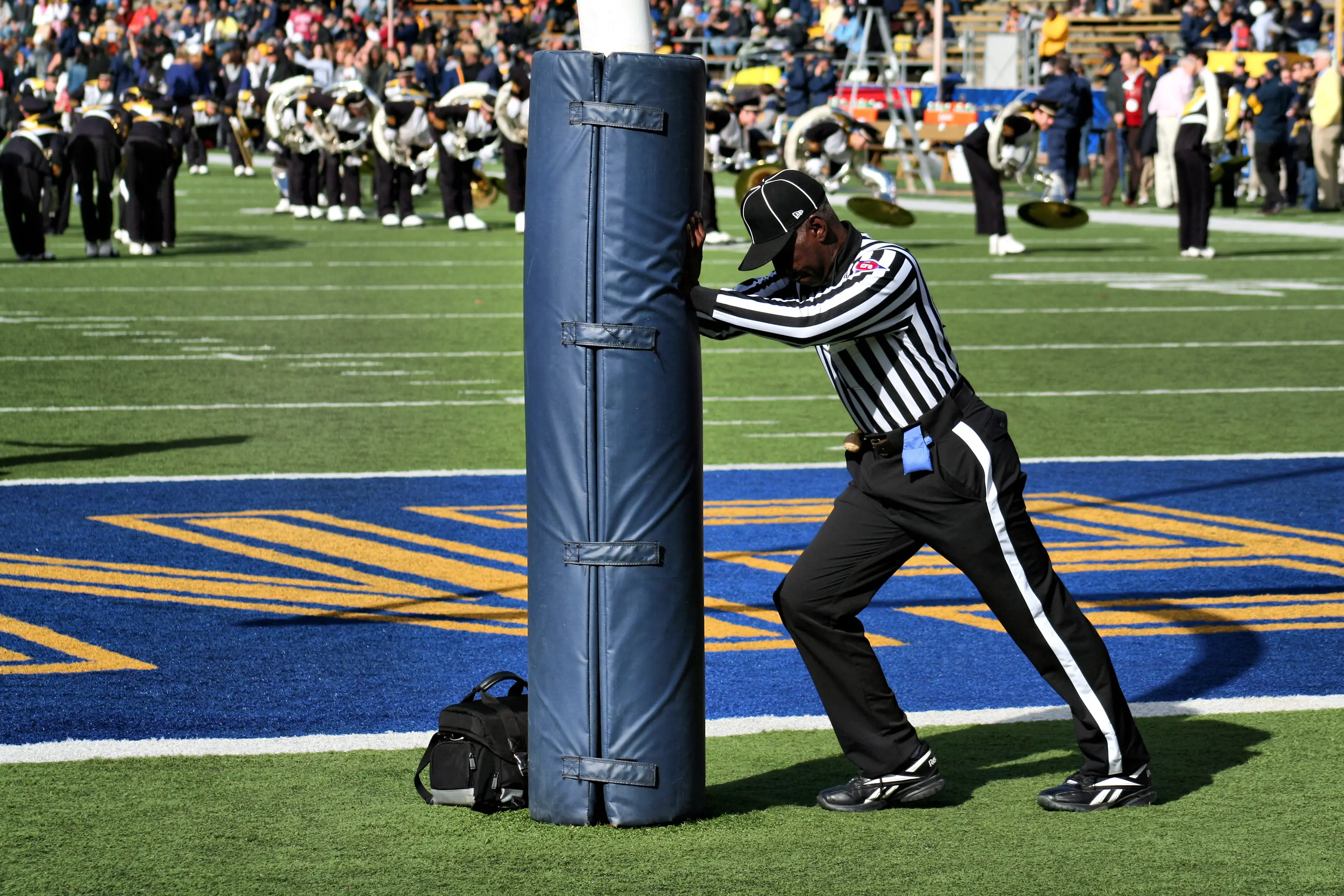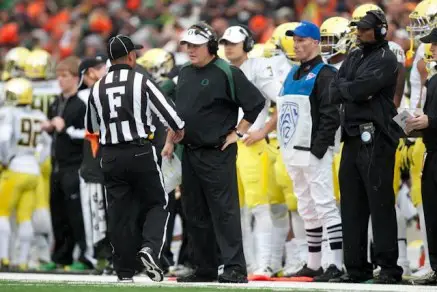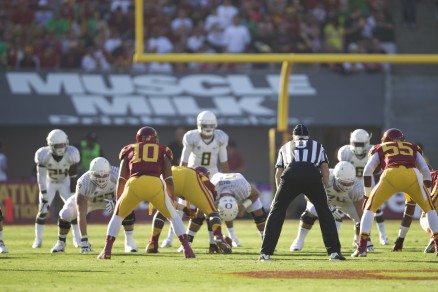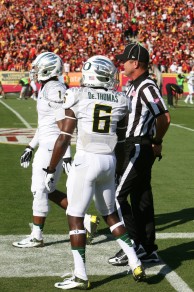Flickr.com
FishDuck takes great pleasure in introducing a new, regular column that will appear on Thursdays and is written by Richard Morgan. Richard can also be read on a regular basis at DuckNews.com.
There is no off season in collegiate football – while the games may stop in January, recruiting, film analysis of both the past season and the opponents on the upcoming schedule, tweaks to the playbook due to graduation or coaching changes and much more, make fielding a team each fall a year-round process.
One of the off-season tasks that occasionally slips beneath the radar is the NCAA Rules and Competition Committee’s annual review of the current state of the game and it’s suggestions for rules changes to be implemented in the coming year. The 13 members of the committee are charged with developing the language of the rule and publishing the official rulebook, but it is the crew-of-seven wearing the striped shirts who are responsible for enforcing those rules on the field of play.
It is the responsibility of each conference to recruit and maintain a pool of accredited game officials to fulfill game assignments.
From the Pac-12 Conference Guidebook: “The Conference annually shall compile a list of approved officials comprised of individuals who demonstrate superior ability to officiate a particular sport and the capability to work games at the major college level. Specific game assignments will be made from the list for the ensuing academic year upon the offer and acceptance of an officials’ contract for the specific sport. Appointment to the list does not guarantee any game assignments. If an official is offered and accepts a contract for independent officiating services with the Conference and specific game assignment(s) are offered, said assignment(s) are for the upcoming season only and do not guarantee listing or assignments beyond the specific season designated in the contract. All such contracts are for one year only.”
To be sanctioned by the conference, each official must (also from the Pac-12 Conference Guidebook) –
“a. Have demonstrated proficiency in officiating. Such proficiency may be established through submission of reports and recommendations by persons knowledgeable about officiating and the applicant’s work as an official and/or through observation of the applicant by a Conference representative.
b. Demonstrate the proper physical attributes, conditioning, and appearance required to officiate on the Conference level.
c. Possess the maturity and judgment to command the respect of college players and coaches so as to maintain control of any game the official may officiate and thereby assure safe playing conditions for the participants.
d. Have sufficient freedom in his or her occupation to enable the official to attend the annual Conference clinic and weekly area association meetings during the season.
e. Provide evidence of a proper physical examination from a medical doctor.
f. Live within the Conference area or in close proximity. (8/85)
g. Shall grant the Conference prior approval to conduct background checks on him/her at the discretion of the Conference.” (9/07)
Subsequent to each season, each official will be evaluated prior to appointment to the list of approved officials for the following academic year, and the Conference may or may not offer a contract to the official for the next upcoming year at the sole discretion of the Conference. In addition, the conference also makes the following stipulations:
a. Playing Rules Test: A football official must pass an NCAA football rules test with a score of at least 70 percent in order to officiate in the Conference. Officials may retake the test in order to secure the minimum score.
b. Practice Sessions and Scrimmages: Football officials may work an unlimited number of institutional practices or scrimmages during pre-season and spring practice periods, but may not work at practice sessions or scrimmages during the regular season.
c. Instructions to Timers: The Conference office will publish instructions for official timers of Conference football games and distribute them to the timers. The timers will be instructed further to meet with the game officials prior to each Conference football game.
d. Identification of Officials: Conference football officials shall be identified with letters on the back of their uniform shirt representing field positions (e.g., “R”-referee, “U”-umpire).
e. Video Evaluators: Video evaluators shall be paid $325 per game and provided with either actual mileage to a local game site or airfare to a non-local game site. If a video evaluator views a game in his local area or drives a reasonably short distance to a game, a per diem of $50 will be provided. For long driving trips or when flying to a game site, a per diem of $190 will be provided to the video evaluator for one or two days, as needed. Game tapes provided to video evaluators for review shall be sideline/end zone intercut and in continuity game sequence.
If accepted and assigned to work a game for a member institution, a Pac-12 football official is paid a $1250 game fee and allowed a per diem of $220 for the day preceding the contest the official is scheduled to officiate. The instant replay official is compensated at the same rate while the instant replay communicator receives $800 per contest.
Once the competition committee adopts a series of rule changes, the conference is responsible for developing training materials for both the officials under contract for the upcoming season as well as the coaches and athletes of the member institutions. Generally this is accomplished with video of game situations, lectures and testing to ensure that a full understanding of the rule is in place by the start of the season. Once the season is underway, video review of each game seeks to quantify and refine rule interpretations so that the rules are enforced consistently by each official and crew.
For the 2013 season there are seven major rules changes:
1.) Targeting of a defenseless player – the rule was expanded for this year to include an ejection if deemed to be warranted.
2.) Offensive blocking below the waist – the rule was amended to better define the area on the field that an offensive player may not engage a defender below the waist. That area is now defined as seven yards on either side of the snapper toward each sideline and extends five yards into the defensive secondary and in the other direction all the way to the offensive team’s end line.
3.) 10-second run-off rule – If in the last minute of a half the clock is stopped solely for the benefit of an injured player, 10 seconds can be subtracted from the remaining time if the opposing team desires. The 10 second run-off can be avoided through the use of a time out by the team substituting for the injured player.
4.) Loss of helmet – One of the more controversial rule changes of 2012 is refined to allow the player to remain in the game if his team wishes to expend a time out.
5.) Minimum time necessary to spike the football – In a rule clarification that Oregon fans will quickly recognize from the end of the Ducks’ Rose Bowl victory over Wisconsin in early 2012, there must now be at least three seconds on the clock when the referee spots the ball for the offense to successfully spike the ball to stop the clock.
6.) Changing jersey numbers during the game – the rule was enhanced to require the player changing jersey numeral to announce the change to the referee who will in turn inform the press box and the opposing sideline.
7.) Uniform numerals must contrast with the main color of the jersey – Call this the “Oregon rule” if you like, but it will no longer be permissible for the numeral on the jersey to be defined solely by a contrasting outline.
While it is certain not every whistle will be the correct call, the NCAA and the conference go to extensive lengths to provide their officials with the training and support necessary to ensure the games are administered equitably and efficiently.
——————————————————————————-
Announcements
*Check out our new pregame opponent analysis on Saturday mornings. Our analysis will be unlike any other, so learn what to watch for before the game on Saturday!
*Want some College Football humor? Check out FishDuck.com’s FIRST GIF! (Click here) Pass it along!
*If you would like to join the other 80+ volunteers at FishDuck.com, and have five hours a week to donate… we have slots open for volunteer Editors, Writers, Analysts, Photo Archivists and Social Media Associates. Can you help us manage people? Consider our volunteer Sales Manager and HR Manager positions and give some time each week to help young associates learn! E-mail us at charles@fishduck.
Related Articles:
These are articles where the writer left and for some reason did not want his/her name on it any longer or went sideways of our rules–so we assigned it to “staff.” We are grateful to all the writers who contributed to the site through these articles.




